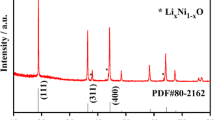Abstract
LiCoPO4 micron-rods with an average diameter of about 500 nm and length of about 5 μm were synthesized by dispersant-aided hydrothermal method. Poly(n-vinylpyrrolidone) (PVP) was used as dispersant in the hydrothermal method. The starting solution and the concentration of dispersant have significant influences on the morphology of LiCoPO4, and the electrochemical performance is improved via controlling the particle size and morphology by the hydrothermal method. The cell using smaller particle LiCoPO4 as cathode delivers a larger capacity and lower cell polarization.
Similar content being viewed by others
References
Howard W.F. and Spotnitz R.M., Theoretical evaluation of high-energy lithium metal phosphate cathode materials in Li-ion batteries, J. Power Sources, 2007, 165(2): 887.
Richardson T.J., Phosphate-stabilized lithium intercalation compounds, J. Power Sources, 2003, 119–121(1): 262.
Romuald S.M. and Sylvain F., Growth of LiCoPO4 single crystals using an optical floating-zone technique, J. Cryst. Growth, 2008, 310: 861.
Kim J.K., Choi J.W., Cheruvally G., et al., A modified mechanical activation synthesis for carbon-coated LiFePO4 cathode in lithium batteries, Mater. Lett., 2007, 61(18): 3822.
Huang Y., Park K.S., and Goodenough J.B., Improving lithium batteries by tethering carbon-coated LiFePO4 to polypyrrole, J. Electrochem. Soc. A, 2006, 153(12): 2282.
Tajimi S., Ikeda Y., Uematsu K., Toda K., and Sato M., Enhanced electrochemical performance of LiFePO4 prepared by hydrothermal reaction, Solid State Ionics, 2004, 175(1–4): 287.
Huang X., Ma J., Wu P., et al., Hydrothermal synthesis of LiCoPO4 cathode materials for rechargeable lithium ion batteries, Mater. Lett., 2005, 59(5): 578.
Zhang H., Ren X., and Cui Z., Shape-controlled synthesis of Cu2O nanocrystals assisted by PVP and application as catalyst for synthesis of carbon nanofibers, J. Cryst. Growth, 2007, 304(1): 206.
Bramnik N.N., Bramnik K.G., Baehtz C., and Ehrenberg H., Study of the effect of different synthesis routes on Li extraction-insertion from LiCoPO4, J. Power Sources, 2005, 145: 74.
Bramnik N.N., Bramnik K.G., Baehtz C., and Ehrenberg H., Phase transitions occurring upon lithium insertion-extraction of LiCoPO4, Chem. Mater., 2007, 19: 908.
Author information
Authors and Affiliations
Corresponding author
Rights and permissions
About this article
Cite this article
Zhao, Y., Wang, S., Zhao, C. et al. Synthesis and electrochemical performance of LiCoPO4 micron-rods by dispersant-aided hydrothermal method for lithium ion batteries. Rare Metals 28, 117–121 (2009). https://doi.org/10.1007/s12598-009-0023-5
Received:
Revised:
Accepted:
Published:
Issue Date:
DOI: https://doi.org/10.1007/s12598-009-0023-5




